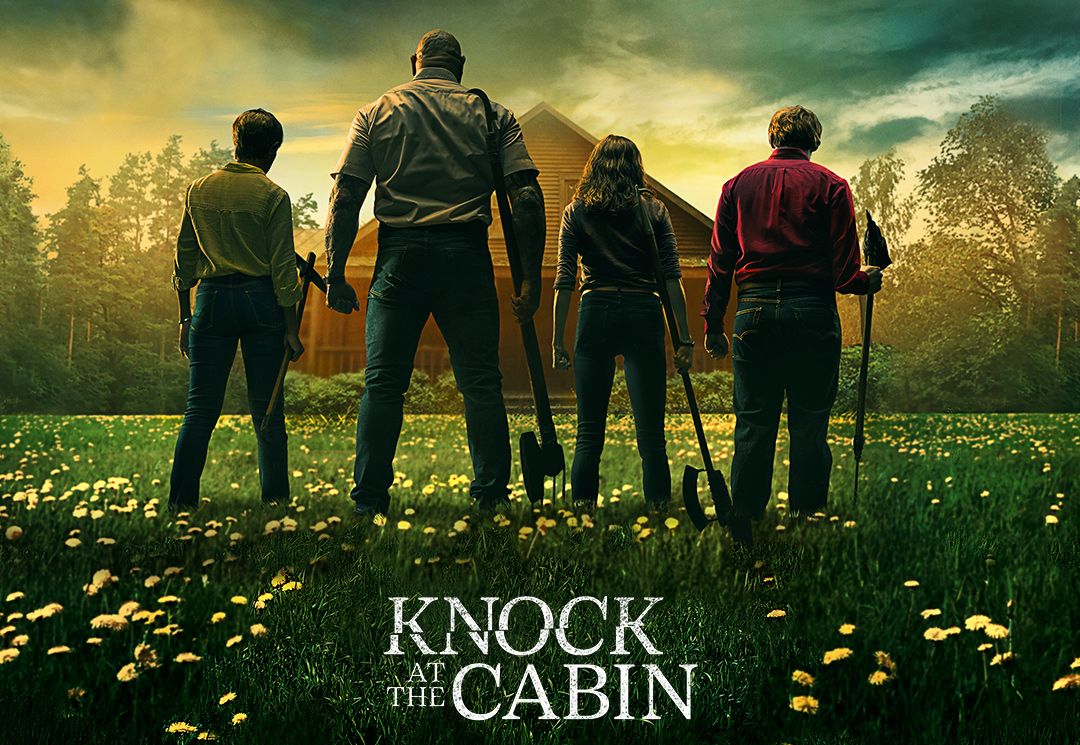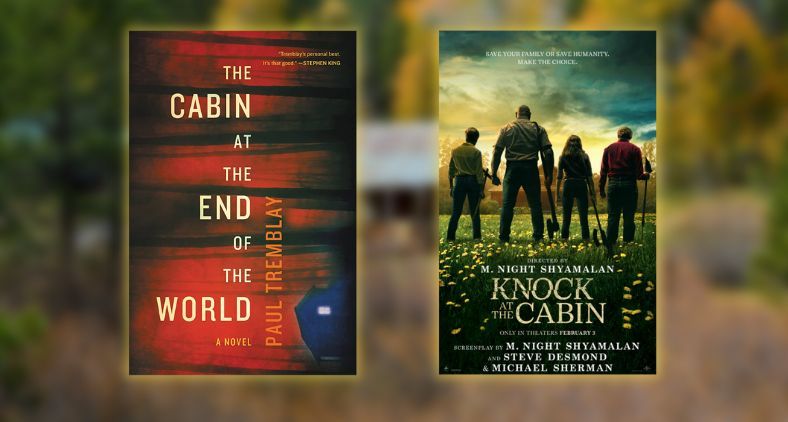
When it was announced that Paul Tremblay’s apocalyptic horror novel Cabin at the End of the World was being adapted as a film by director M. Night Shyamalan, I was incredibly excited, in part because I had no idea how this was going to go. While I’m a fan of both of their works, Shyamalan and Tremblay are very different storytellers, and I was curious to see how Shyamalan would interpret Tremblay’s devastating psychological horror novel for a wider audience.
Unsurprisingly, the movie is different from the book in a lot of ways. And no, it’s not just the title. We open on a scene that will be familiar to Cabin at the End of the World readers. A young girl named Wen is catching crickets and talking to Leonard, a large man who is a stranger to her. As they continue to talk, Wen becomes more and more uneasy with their conversation. Ultimately, Leonard reveals that he is not alone and that he and his friends have come upon Wen and her family at this cabin for a purpose: to stop the end of the world from happening. In order to do this, Wen’s family must make a terrible choice. Either Wen or one of her fathers, Eric or Andrew, must die in order to save the world. From there, the stories deviate pretty heavily, and audiences have had mixed responses to those changes.
Spoilers for Knock at the Cabin and Cabin at the End of the World to follow.
What I find fascinating about this book and its adaptation is that it’s not as simple as “the book is better than the movie,” which is what us book readers love to say about most adaptations. Some people have genuinely preferred the way Shyamalan has chosen to end the story. After reflecting on both stories and their trajectories, I firmly believe Paul Tremblay’s original ending in Cabin at the End of the World is better. But I see value in the two, and the two stories ultimately end up in an interesting conversation with each other.
To unpack the differences in the book and the movie, I talked to author Paul Tremblay. This is the first time the author’s work has been adapted. “It seems very bizarre that I’ve seen the movie twice and it’s actually out, after thinking about the possibility of the book being adapted for almost seven years now,” Tremblay said. Cabin at the End of the World was published in 2018, but the author said there was talks about the story being made into a film even before he’d finished writing the book.
Tremblay said when M. Night Shyamalan became attached to the project, “he’s very much in control of his vision,” and so he knew he was going to have to give up some control over his own story. “That being said,” Tremblay added. “I really appreciated Film Nation letting me look at the screenplay and give notes because they weren’t contractually obligated to do so.”
While there are some subtle changes throughout the first half of Knock at the Cabin, the first major change between the book and the movie happens towards the end. In the book, there is a struggle with a gun that ends with Wen tragically being shot and killed. In the movie, Wen lives. From there, the story deviates pretty heavily from its source material. Tremblay said he sees the Wen incident as one of the “fulcrums of the story going in two opposite directions.” And while he would have still preferred Wen to have died in the movie, he admitted, “after meeting Kristen [Cui], I’m sort of glad I didn’t have to watch her die in some ways.”
If you’re wondering why Tremblay (and so many readers) feel strongly about the importance of Wen’s death in the film, here’s how the author explains it. “Typically, horror is accused of desensitizing violence for people as opposed to heightening your response to it. And I think that was sort of what I was trying to do with Wen’s death in the story,” Tremblay said. “It served as a reminder to the reader, hey, this is what’s being asked of this family. This horrible violent stuff. And I go into way more detail than I usually do with violence because I wanted to show that this family is being asked to participate in this horrible, vicious, immoral, violent act. To make it harder for the reader.”
When Wen dies in the novel, it is a truly shocking moment, and something that would have been undeniably difficult to watch on screen, so it makes sense that Shyamalan would take that moment out of Knock at the Cabin. However, by doing so, the movie is forced to go in a different direction for the rest of its run time. In the book, uncertain about their future and devastated by the loss of their child, Eric and Andrew decide that they refuse to sacrifice themselves to save the world. In the film, because Wen is still alive, Eric insists on sacrificing himself in the hopes of giving Wen a future.
The other major difference that becomes quite obvious early on in Knock at the Cabin is its lack of ambiguity. While in the book it’s unclear whether an apocalypse is happening or not, the movie is pretty explicit. We witness horrifying storms and planes falling out of the sky. With all of the evidence, it’s difficult to deny that the end of the world is actually happening. This also impacts Eric and Andrew’s choice at the end of the movie.
“The movie sort of has the ambiguous element for the first two acts,” Tremblay said. But from there, as the terror of the end of the world plays out on screen, Shyamalan’s film comes with some chilling implications. Tremblay explains, “As an agnostic who’s been around Catholic institutions, one of my own fears is what if there is a supreme being and he’s intolerably cruel. And that’s to me how the movie ends. It’s really horrifying. It pushes my buttons in a horror way that not only do Andrew and Wen have to live with the knowledge that they chose to kill Eric. They have to live with the knowledge that there’s this whimsically cruel supreme being that forced all of this stuff to happen. How do they go on with that? I’m kind of weirdly interested in what happens to the movie versions of Andrew and Wen after that. In the moment, they save the world. But at what cost to them?”
A lot of what I’ve been thinking about since I watched Knock at the Cabin is the bleakness of it all. And what ending is more devastating? Which is more hopeful? I keep going back and forth on that. On the one hand, Eric and Andrew make the decision in the film the the world is worth saving, and that seems optimistic. On the other hand, there’s something painfully romantic about the way the book ends. These two people don’t know what the future holds for them. They don’t know if the apocalypse is really happening or not, but no matter what happens in their future, they want to go through it together.
In many ways, the book’s ending is reflective of real life and our experiences in this moment in history, which is one of the things I appreciated so much about it. Paul Tremblay explained, “For me, in the book, part of the reason I left it purposefully ambiguous was because I wanted the book to feel like, when I was writing it in 2016, those fears I had about the reveal of Trumplandia. All of those anxieties that all of us had and continue to have, that whenever you look at your phone or your television or your feed that it feels like there’s an apocalypse happening. Maybe it’s already happened, and it’s just happening in slow motion. We don’t know. So it was important to me not to ever say, hey, there’s directly an apocalypse happening. Whether there is or isn’t, I thought Andrew and Eric choosing not to succumb to fear or violence is a hopeful act. That basically, even if there is an apocalypse happening, them saying ‘this is wrong, this is immoral, we refuse to participate.’ To me, that felt like a defiant hopefulness I wanted at the time I was writing the book. Whether other people see that as being hopeful, I’m not sure.”
I’ve spent a lot of time contemplating both the book and the movie and what both are saying, and every time I think about it, I come away with different answers. To me, that’s a sign that both the book and the film are saying interesting things about humanity, about faith, and about the world we currently live in. While Tremblay and Shyamalan might have different answers to all of the questions this story poses, they’re both offering valid and noteworthy explorations of these themes.
But what did Paul Tremblay think of Knock at the Cabin? “I think visually it’s stunning,” he said. “I love the direction and composition of so many of the shots. I thought the actors all nailed it, both in terms of the movie story and inhabiting the characters too. I really do like the movie. And the more time passes, the more I enjoy thinking about the differences and the implications between the two. And I hope that people who read the book and see the movie take it that way too. The responses of friends and readers have been all over the map, which has been interesting. And I hope that’s a sign that both the book and the movie are good and interesting, because people are having really strong reactions one way or the other. I’d rather that than just a shrug of the shoulders.”
Knock at the Cabin is currently playing in theaters and available to stream on many streaming services, including Apple TV and YouTube. Paul Tremblay’s next book, a short story collection entitled The Beast You Are, will be out from William Morrow on July 11.
